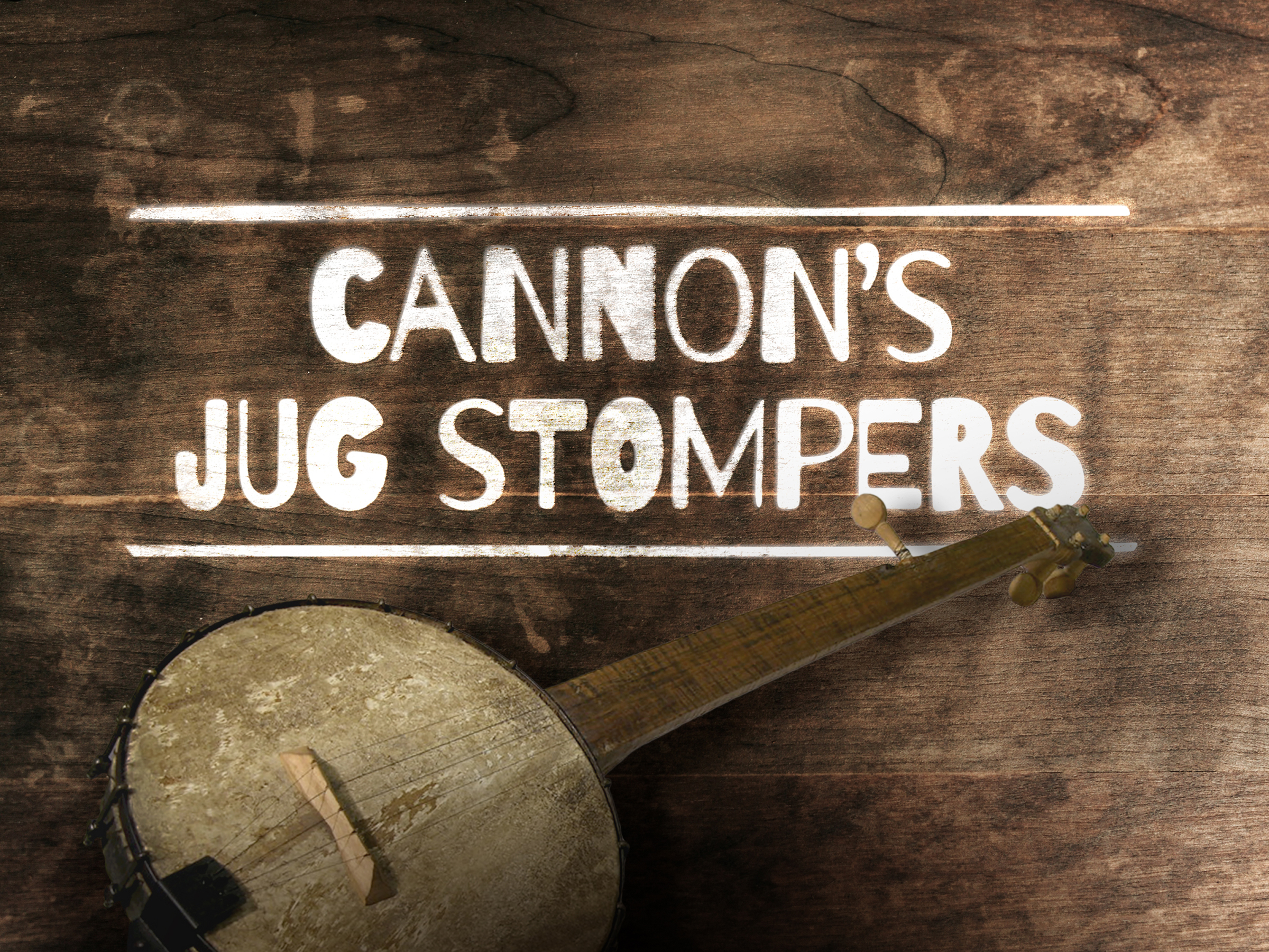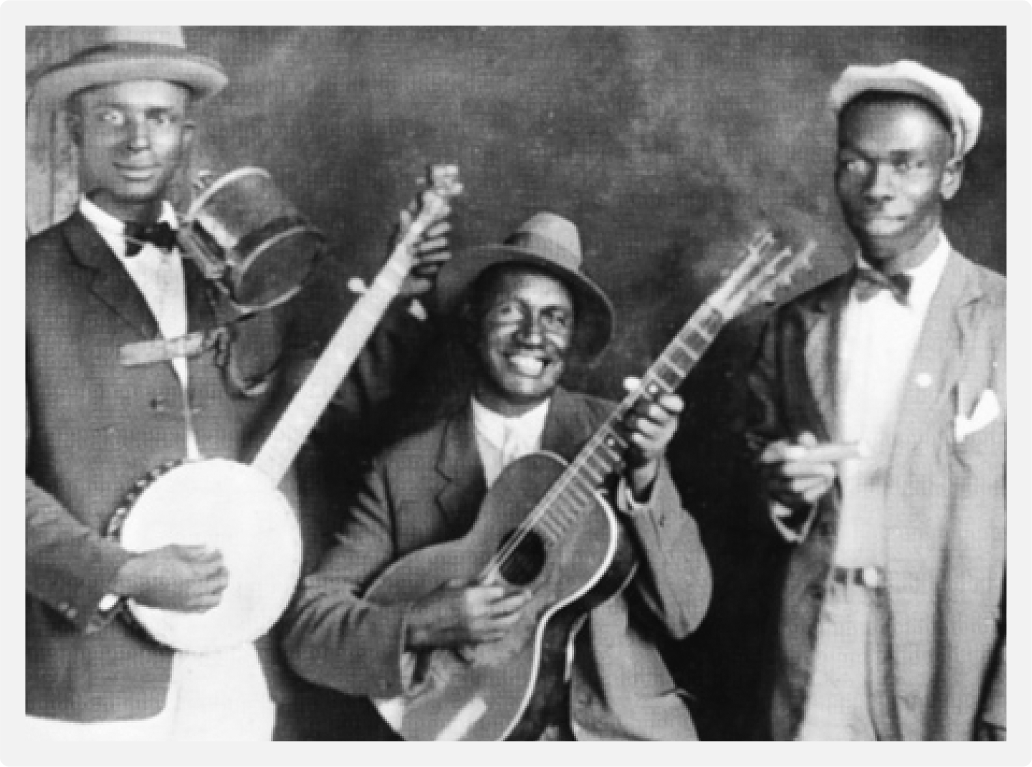
In the early 1900s, the jug band emerged in the urban areas around Louisville, Kentucky and Memphis, Tennessee. Early jug bands were typically made up of out-of-work vaudeville and medicine show musicians. They were typically street performers who played in hopes of earning money from people passing by. However, some jug bands earned record contracts and toured. They usually played a mixture of blues, ragtime and jazz, however low pay often required that these creative musicians use recycled or hand-me-down instruments, or utilize their musical genius to create instruments from found or readily available items, including jugs (thus the name), washtub bass, washboards, etc. Other instruments include guitars, banjos, fiddles, harmonicas, Jew’s harp, etc. The informal and energetic music of the jug bands also contributed to the development of rock and roll.
Cannon’s Jug Stompers, led by Gustavas “Gus” Cannon, was one of the all-time great jug bands, perhaps the best at capturing the full flavor of the rural countryside’s delightful rhythms and haunting expressiveness. Their repertoire covered the whole panorama of American rural music: rags, blues, breakdowns, tin pan alley, minstrel and more!


Gus Cannon was a banjo-playing jack-of-all-trades whose musical abilities included trombone, fiddle, piano, and guitar. He was born in Red Banks, Mississippi. His parents, John and Ellen, were sharecroppers; his father had been a slave. Gus was the youngest of 10 brothers. At the age of twelve Cannon moved to Clarksdale, Mississippi, then the home of W.C. Handy. While there he made his first banjo. He ran away from home at the age of fifteen and began his career entertaining at sawmills and levee and railroad camps in the Mississippi Delta around the turn of the century. By the time he was 19 Gus was playing at Saturday night balls for $2.50 a night as well as working other odd jobs in the area. By 1901 Gus had gotten a job working for the railroad at Belzoni, near Greenville Mississippi. It was at this time that he formed his first jug band with Jim Guffin. While in Clarksdale, Cannon was influenced by two local musicians, Jim Turner and Alec Lee. Turner’s fiddle playing in W. C. Handy’s band impressed Cannon so much that he decided to learn to play the fiddle himself. Lee, a guitarist, taught Cannon his first folk blues, “Po’ Boy, Long Ways from Home,” and showed him how to use a knife blade as a slide, a technique that Cannon adapted to his banjo playing.
In 1907 he went to work at a plantation near Ashport, Tennessee. Gus would spend his weekends in nearby Ripley, and it was here, on a Sunday afternoon, that he met Noah Lewis. Noah was born on Glimpse Farm in Lauderdale County, outside Henning, Tennessee around 1890. Noah was a harp player, in fact he was known for being able to play two harps at once, one with his mouth and the other with his nose. Together they would play parties, suppers, and breakdowns around Memphis. During the 1910s and 1920s, Cannon also joined Jim Jackson for medicine shows, playing, juggling, and doing comedy routines in the role of “Banjo Joe.” He supported his family through a variety of jobs, including sharecropping, ditch digging, and yard work, but supplemented his income with music.
Featuring Cannon, Noah Lewis, and Ashley Thompson on guitar/banjo (a six-string guitar with a banjo head), Cannon’s Jug Stompers was first recorded at the Memphis Auditorium for the Victor label in January 1928. Will Shade of the Memphis Jug Band had recommended Cannon’s Jug Stompers to Victor, his record label. After this first session, Elijah Avery replaced Thompson, first on guitar and then switching to banjo, giving the band a twin-banjo attack. Lewis’s harmonica virtuosity and Avery and Cannon’s complementary banjo picking created a traditional, down-home sound. Hosea Woods joined the Jug Stompers in the late 1920s, playing guitar, banjo and kazoo and providing vocals. Cannon’s Jug Stompers “Big Railroad Blues” recording was included on the compilation album, The Music Never Stopped: Roots of the Grateful Dead.
Although their last recordings were made in 1930, Cannon’s Jug Stompers were one of Beale Street’s most popular jug bands throughout the decade of the 30s. A few songs Cannon recorded with the Jug Stompers are “Minglewood Blues,” “Pig Ankle Strut,” “Viola Lee Blues,” “White House Station,” and “Walk Right In”. There’s a relaxed laziness to pieces like “Wolf River Blues” and “The Rooster’s Crowing Blues” that separate the group from noisier, more boisterous bands like the Skillet Lickers. The band’s 1928-1930 recordings for the Victor label not only established them as important artists of the era but also had an impact decades later when folk and rock acts began to revive elements of the jug band style and repertoire.
By the end of the 1930s, Gus Cannon had effectively retired, although he occasionally performed as a solo musician. Cannon made a few recordings for Folkways Records in 1956. During the blues revival of the 1960s, he made some appearances at colleges and coffee houses with Furry Lewis and Bukka White, but he had to pawn his banjo to pay his heating bill the winter before The Rooftop Singers had a big hit with “Walk Right In” in 1963. The Rooftop Singers’ version, when released as a single, spent two weeks at No.1 on the Billboard Hot 100 chart in early 1963. It spent five weeks atop the Adult Contemporary chart.
The Grateful Dead recorded Cannon’s ‘Viola Lee Blues,’ among others, and the Lovin’ Spoonful transformed his ‘Prison Wall Blues’ into ‘Younger Girl.’ The renewed attention enabled Cannon to record an album for the Stax label in Memphis. For that recording, he teamed with fellow Memphis musicians Will Shade (the former leader of the Memphis Jug Band) on jug and Milton Roby on washboard. Cannon performed traditional songs, including “Kill It,” “Salty Dog,” “Going Around,” “The Mountain,” “Ol’ Hen,” “Gonna Raise a Ruckus Tonight,” “Ain’t Gonna Rain No More,” “Boll-Weevil,” “Come On down to My House,” “Make Me a Pallet on Your Floor,” “Get Up in the Morning Soon,” and “Crawdad Hole,” along with his own “Walk Right In,” with stories and introductions between songs.
Gus Cannon’s advanced age prevented Cannon from enjoying many fruits of the blues revival. He died in Memphis on Oct. 15, 1979, at 96 years of age.
Be the first to add your voice.